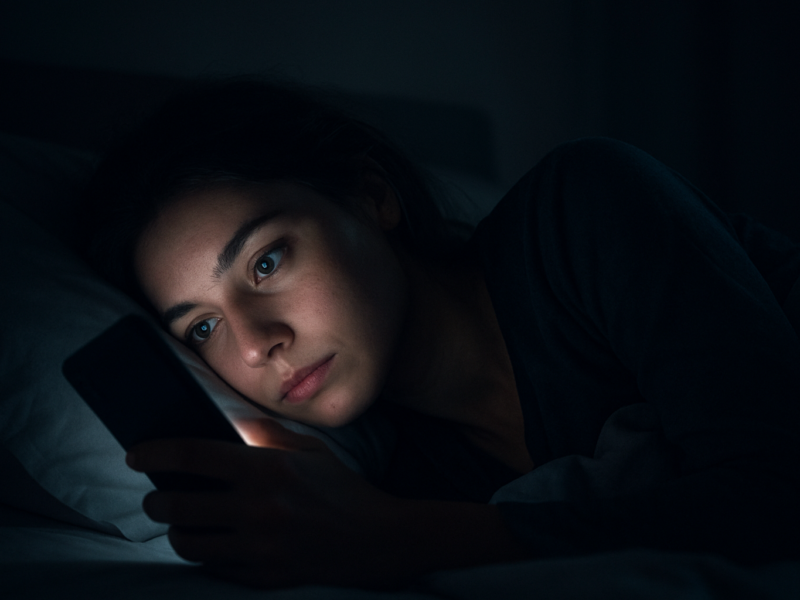2. Understanding Blue Light (Science Behind the Glow)
Blue light belongs to the high-energy visible (HEV) spectrum with wavelengths between 380–500 nanometers.
While natural blue light from the sun regulates our sleep-wake cycle, alertness, and mood, artificial blue light from digital screens (phones, monitors, LED lights) can cause visual fatigue and disrupt circadian rhythm.
In short:
- 🌞 Natural blue light = good for your biological rhythm.
- 💻 Artificial blue light = potentially harmful in excess.
3. Myths vs. Facts about Blue Light
- ❌ Myth 1: Blue light is the main cause of blindness.
✅ Fact: No strong evidence links normal screen exposure directly to blindness. - ❌ Myth 2: Blue light glasses solve all eye problems.
✅ Fact: They help reduce strain but lifestyle changes are just as important. - ❌ Myth 3: Only young people/gamers need protection.
✅ Fact: Professionals, children, and seniors are equally at risk.
4. Short-Term Effects of Blue Light Exposure
- Digital eye strain: blurred vision, dryness, headaches.
- Sleep cycle disruption (melatonin suppression).
- Psychological fatigue (screen overload).
5. Long-Term Risks (Debated & Under Research)
- Macular degeneration connection (what studies say).
- Possible retinal stress from cumulative exposure.
- Mental health and circadian rhythm effects.
💡 Did You Know?
Natural blue light from the sun helps regulate your body’s sleep–wake cycle, mood, and alertness — while artificial blue light from screens can disrupt it at night.
6. Proven Strategies for Protection
🖥️ Device Settings
Use Night Shift, Night Light, True Tone, or apps like f.lux and Iris to filter HEV light.
🕶️ Glasses & Filters
Modern blue light glasses come with anti-glare and UV filters.
You can also apply hardware or software screen filters.
💡 Ergonomic Adjustments
- Maintain screen at eye level, ~60 cm away.
- Keep room well-lit to reduce contrast.
- Adjust brightness to match ambient light.
🥗 Nutrition & Lifestyle
- Eat foods rich in lutein, zeaxanthin, and omega-3.
- Set screen-free hours before bedtime.
- Follow the 20-20-20 rule (every 20 minutes, look 20 feet away for 20 seconds).
7. Blue Light and Different Age Groups
- 👦 Children & Teens: Sensitive retinas, disrupted sleep cycles.
- 💻 Remote Workers: Long exposure post-pandemic increases digital strain.
- 🎮 Gamers: Extended night sessions heighten risk of visual fatigue.
- 👵 Seniors: Aging retinas and lens yellowing increase vulnerability.
8. Role of Employers & Schools
Forward-thinking companies now:
- Provide eye wellness programs.
- Install low blue light monitors.
- Encourage micro-breaks and digital hygiene.
Schools are adopting digital safety modules to teach children proper screen use.
9. Daily Habits Checklist for Eye Comfort
✅ Follow the 20-20-20 rule
✅ Stay hydrated and blink often
✅ Avoid screens 2 hours before sleep
✅ Maintain good indoor lighting
✅ Take eye breaks every hour
10. The Future of Blue Light Research & Technology
- 🖥️ OLED and E-Ink screens emit less harmful light.
- 🕶️ Smart glasses with adaptive filters are in development.
- 🔬 Ongoing research continues to separate myths from evidence.
❓ FAQ
Q1: Do I need blue light glasses if my phone has a filter?
A: Glasses offer extra protection, especially for long sessions or multiple screens.
Q2: Can blue light damage my eyes permanently?
A: Normal screen exposure doesn’t cause permanent damage, but prolonged unfiltered exposure may lead to strain or sleep disruption.
Q3: How many hours of screen time is “safe”?
A: Experts recommend limiting continuous screen time to 2 hours followed by a short break.
Q4: Can I reduce blue light naturally?
A: Yes — by spending time outdoors during daylight and maintaining a balanced diet rich in antioxidants.
11. Conclusion
Blue light isn’t inherently evil — it’s about balance, awareness, and smart habits. Protect your vision today to enjoy healthy eyes tomorrow.”



